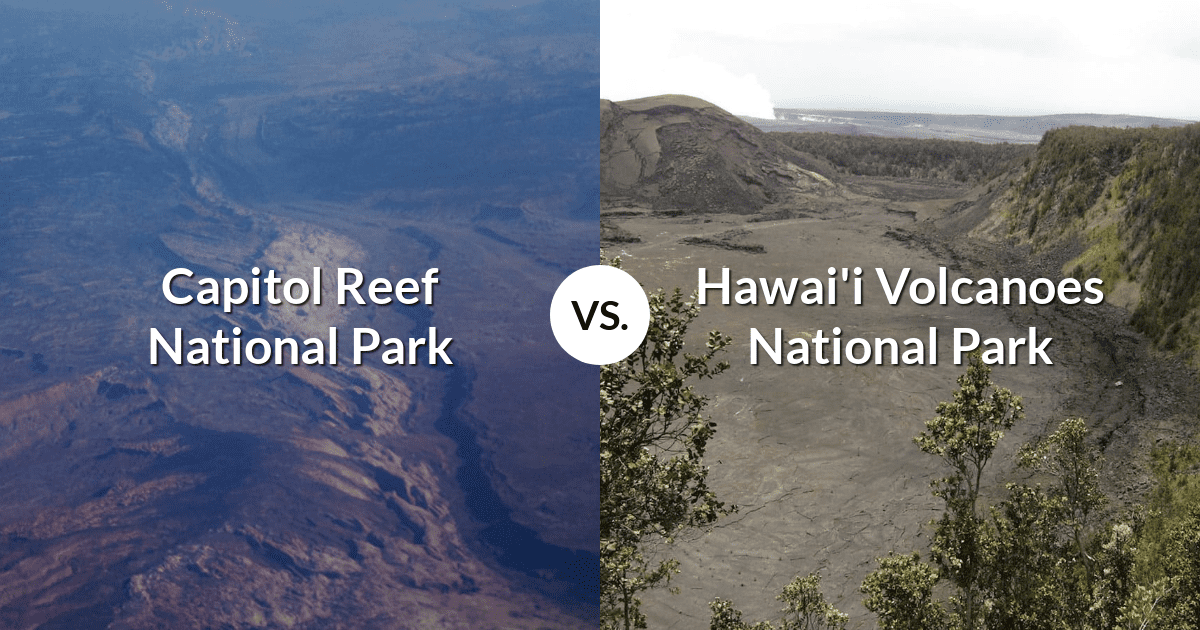Jake Cain is an entrepreneur and writer from Cincinnati, Ohio. He spends his free time driving around the country in his late 90’s conversion van, affectionately known as the “Monster Van” with his wife and 3 boys.
Capitol Reef National Park and Hawaii Volcanoes National Park are two of America’s most unique and captivating national parks. While one showcases the beauty of the desert landscape, the other showcases the raw power of volcanic activity. Both parks offer visitors the opportunity to explore diverse landscapes, witness breathtaking natural wonders, and experience the great outdoors. Whether you’re a nature lover, a hiker, or simply someone in search of adventure, these two parks are sure to leave a lasting impression. From the towering red rock formations of Capitol Reef to the fiery volcanic craters of Hawaii Volcanoes, each park has its own unique charm and beauty. So, whether you’re a seasoned national park traveler or a first-time visitor, don’t miss the chance to explore these two amazing parks!
Hiking Trails in Capitol Reef National Park and Hawai’i Volcanoes National Park
Capitol Reef National Park and Hawaii Volcanoes National Park both offer a range of hiking trails for visitors to enjoy.
At Capitol Reef National Park, some of the most popular hikes include the Grand Wash Trail, which is an easy hike that leads to a scenic slot canyon, and the Cassidy Arch Trail, which is a moderate hike that leads to a stunning arch with views of the surrounding landscape. For those looking for a more challenging hike, the Upper Muley Twist Canyon hike is a strenuous hike that takes visitors through a narrow and twisting canyon.
At Hawaii Volcanoes National Park, visitors can hike to the summit of Kilauea, one of the world’s most active volcanoes, on the Crater Rim Trail, which is a moderate hike that takes visitors through a diverse landscape of volcanic features. Another popular hike is the Devastation Trail, which is an easy hike that leads to a viewpoint overlooking the devastation caused by the eruption of Kilauea in 2018. For those looking for a more challenging hike, the Mauna Loa Summit Trail is a strenuous hike that takes visitors to the summit of Mauna Loa, the largest shield volcano in the world.
Both parks offer a range of hiking options, from easy walks to challenging hikes, making them both great destinations for hikers of all abilities.
Most Popular Hiking Trails in Capitol Reef National Park
| Name | Length | Elevation | Type | Difficulty | Visitor Ratings |
|---|---|---|---|---|---|
| Hickman Bridge Trail | 2735.878 | 129.8448 | Moderate | out and back | 4.5 |
| Cassidy Arch Trail | 4667.086 | 213.9696 | Moderate | out and back | 4.5 |
| Grand Wash Trail via Northeast Trailhead | 7081.096 | 121.92 | Easy | out and back | 4.5 |
| Chimney Rock Loop Trail | 5310.822 | 241.7064 | Moderate | loop | 4.5 |
| Cohab Canyon Trail | 4828.02 | 241.7064 | Moderate | out and back | 4.5 |
| Navajo Knobs Trail | 14001.258 | 650.748 | Hard | out and back | 4.5 |
| Goosenecks & Sunset Point | 4023.35 | 165.8112 | Easy | out and back | 4.5 |
| Capitol Gorge Trail | 7242.03 | 113.9952 | Moderate | out and back | 4 |
| Sulphur Creek Route | 18507.41 | 427.9392 | Easy | out and back | 4.5 |
| Rim Overlook Trail | 6598.294 | 320.9544 | Hard | out and back | 4.5 |
Most Popular Hiking Trails in Hawai’i Volcanoes National Park
| Name | Length | Elevation | Type | Difficulty | Visitor Ratings |
|---|---|---|---|---|---|
| Kilauea Iki Trail and Crater Rim Trail | 4828.02 | 209.7024 | Moderate | loop | 4.5 |
| Kalapana Lava Viewing | 15288.73 | 196.9008 | Easy | out and back | 4.5 |
| Pu’u Huluhulu via Napau Crater Trail | 4023.35 | 94.7928 | Moderate | out and back | 4.5 |
| Halema���uma���u Steam Bluff and Sulfur Banks | 2092.142 | 24.9936 | Easy | loop | 4 |
| Puu Loa Petroglyphs Trail | 1931.208 | 25.908 | Moderate | out and back | 4 |
| Mauna Loa via Observatory Trail and Summit Trail | 20760.486 | 905.8656 | Very Hard | out and back | 4.5 |
| Devastation Trail to Puu Puai Overlook | 1609.34 | 37.7952 | Easy | out and back | 3.5 |
| End of Chain of Craters Road Trail to Lava Viewing | 16576.202 | 130.7592 | Moderate | out and back | 4 |
| Sandalwood (Iliahi) Trail | 1931.208 | 13.716 | Moderate | loop | 4 |
| Halema’uma’u Trail | 2735.878 | 130.7592 | Moderate | out and back | 4.5 |
Wildlife in Capitol Reef National Park and Hawai’i Volcanoes National Park
Capitol Reef National Park and Hawaii Volcanoes National Park both offer unique wildlife experiences. Capitol Reef is home to a variety of desert animals such as desert bighorn sheep, rock squirrels, and rattlesnakes. The park also has a rich birdlife, including species like the pinyon jay, phainopepla, and the western tanager. Additionally, the park is known for its diverse plant life, with species like the Utah juniper, pinyon pine, and yucca.
Hawaii Volcanoes National Park, on the other hand, is home to a diverse array of endemic species found nowhere else in the world. The park is a habitat for the Hawaiian goose, Hawaiian hawk, and the nene. In addition to these birds, the park is also home to a variety of plants, including ferns, ohia, and hapu’u. The park is also famous for its volcanic landscapes and features, including the active Kilauea volcano and the otherworldly landscapes of the volcanic deserts.
Below are lists of the most commonly spotted wildlife at Capitol Reef National Park and Hawai’i Volcanoes National Park. However, you can see a full list of wildlife at each national park here.
Birds
| Capitol Reef National Park | Hawai’i Volcanoes National Park |
|---|---|
| Peregrine Falcon | Peregrine Falcon |
| Northern Harrier | Canada Goose |
| Sharp-Shinned Hawk | Great Blue Heron |
| Osprey | Rock Pigeon |
| Tree Swallow | House Sparrow |
| Mallard | Northern Mockingbird |
| Canada Goose | Black-Crowned Night-Heron |
| Lincoln’s Sparrow | Wild Turkey |
| Ruby-Crowned Kinglet | Barn Owl |
| American Robin | Cattle Egret |
| Great Horned Owl | Sanderling |
| Red-Tailed Hawk | Ring-Necked Pheasant |
| Northern Flicker | Chukar |
| Merlin | Ruddy Turnstone |
| Barn Swallow | Northern Cardinal |
| Savannah Sparrow | California Quail |
| Great Blue Heron | |
| Hermit Thrush | |
| American Kestrel | |
| Bald Eagle | |
| Song Sparrow | |
| European Starling | |
| Northern Pintail | |
| American Wigeon | |
| Green-Winged Teal |
Mammals
| Capitol Reef National Park | Hawai’i Volcanoes National Park |
|---|---|
| Coyote | House Mouse |
| American Beaver | Norway Rat |
| Muskrat | ‘Iole |
| Big Brown Bat | Domestic Cattle |
| Bobcat | Feral Hog |
| Striped Skunk | |
| Little Brown Bat | |
| Deer Mouse | |
| Raccoon | |
| Black Bear | |
| Porcupine | |
| Silver-Haired Bat | |
| Hoary Bat | |
| Red Fox | |
| Long-Tailed Weasel | |
| House Mouse | |
| Mountain Lion | |
| American Mink | |
| Mule Deer | |
| Common Gray Fox | |
| Long-Legged Myotis | |
| Long-Eared Myotis | |
| American Badger | |
| Ermine | |
| California Myotis |
Fish
| Capitol Reef National Park | Hawai’i Volcanoes National Park |
|---|---|
| Rainbow Trout | |
| Brown Trout | |
| Bluegill | |
| Mottled Sculpin | |
| Speckled Dace | |
| Black Bullhead | |
| Cutthroat Trout |
Reptiles
| Capitol Reef National Park | Hawai’i Volcanoes National Park |
|---|---|
| Gophersnake | |
| Terrestrial Gartersnake | |
| Prairie Rattlesnake | |
| Common Sagebrush Lizard | |
| Greater Short-Horned Lizard | |
| Side-Blotched Lizard | |
| Common Kingsnake | |
| Nightsnake | |
| Long-Nosed Leopard Lizard | |
| Striped Whipsnake | |
| Smith’s Black-Headed Snake | |
| Tree Lizard | |
| Western Whiptail | |
| Western Skink | |
| Desert Spiny Lizard |
Amphibians
| Capitol Reef National Park | Hawai’i Volcanoes National Park |
|---|---|
| Northern Leopard Frog | Bullfrog |
| Tiger Salamander | |
| Woodhouse’s Toad | |
| Red-Spotted Toad | |
| Canyon Treefrog |
Insects
| Capitol Reef National Park | Hawai’i Volcanoes National Park |
|---|---|
| Painted Lady | |
| Monarch Butterfly | |
| American Painted Lady | |
| Red Admiral | |
| Cabbage White | |
| Honey Bee |
Beautiful Landscapes in Capitol Reef National Park and Hawai’i Volcanoes National Park
Capitol Reef National Park:
– Waterpocket Fold: A 100-mile long wrinkle in the Earth’s crust, the Waterpocket Fold is one of Capitol Reef’s most iconic landmarks. Visitors can hike through the fold, taking in the towering cliffs and unique rock formations.
– Cathedral Valley: A remote and serene valley, Cathedral Valley is home to towering monoliths and unique rock formations. Visitors can hike through the valley and take in the breathtaking views.
– Chimney Rock: A towering spire of rock, Chimney Rock is one of Capitol Reef’s most recognizable landmarks. Visitors can hike to the base of the rock and take in the panoramic views of the surrounding landscape.
Hawaii Volcanoes National Park:
– Kīlauea Volcano: One of the world’s most active volcanoes, Kīlauea has been continuously erupting since 1983. Visitors can witness the power of the volcano and see the molten lava flowing into the ocean.
– Mauna Loa: The world’s largest shield volcano, Mauna Loa is a massive mountain that rises over 13,000 feet from the ocean floor. Visitors can hike to the summit and take in the breathtaking views of the surrounding landscape.
– Thurston Lava Tube: A massive underground cave, the Thurston Lava Tube is a unique and fascinating feature of Hawaii Volcanoes National Park. Visitors can take a guided tour of the lava tube and learn about the volcanic activity that formed it.
Both Capitol Reef National Park and Hawaii Volcanoes National Park offer visitors the chance to witness breathtaking natural wonders. Whether it’s the towering rock formations of Capitol Reef or the fiery volcanic craters of Hawaii Volcanoes, these parks are sure to leave a lasting impression. So, whether you’re a seasoned national park traveler or a first-time visitor, don’t miss the chance to explore these amazing landscapes!
Things To-Do and Activities in Capitol Reef National Park and Hawai’i Volcanoes National Park
Capitol Reef National Park and Hawaii Volcanoes National Park are both popular destinations that offer a range of activities for visitors.
Capitol Reef National Park:
– Hiking: With its diverse landscape, Capitol Reef offers a range of hiking options, from easy nature walks to challenging backcountry treks. Visitors can explore the park’s canyons, mesas, and valleys on foot and take in the breathtaking views.
– Scenic Drives: The park’s scenic drive provides access to many of the park’s most iconic landmarks and offers stunning views of the surrounding landscape. Visitors can stop at various overlooks and take in the panoramic views.
– Rock Climbing: For the adventurous, Capitol Reef offers opportunities for rock climbing and technical canyoneering. Visitors can explore the park’s towering cliffs and unique rock formations and test their skills on the challenging routes.
Hawaii Volcanoes National Park:
– Hiking: With its diverse landscape, Hawaii Volcanoes offers a range of hiking options, from easy nature walks to challenging backcountry treks. Visitors can explore the park’s volcanic craters, rainforests, and coastlines on foot and take in the breathtaking views.
– Volcano Viewing: With its active volcanoes, Hawaii Volcanoes offers visitors the chance to witness the power of nature. Visitors can witness the molten lava flowing into the ocean, see the steam vents, and feel the heat of the volcano.
– Stargazing: With its clear, dark skies, Hawaii Volcanoes is one of the best places in the world for stargazing. Visitors can take in the breathtaking views of the night sky and see stars, constellations, and even planets that are not visible from other locations.
Both Capitol Reef National Park and Hawaii Volcanoes National Park offer visitors a range of activities to choose from. Whether you’re looking for a peaceful hike through stunning landscapes, an adrenaline-fueled rock climbing adventure, or a chance to witness the power of nature, these parks have something for everyone. So, whether you’re a seasoned national park traveler or a first-time visitor, don’t miss the chance to explore these amazing destinations!
Best Time to Visit Capitol Reef National Park and Hawai’i Volcanoes National Park
Capitol Reef National Park and Hawaii Volcanoes National Park have vastly different climates, which affects the best time to visit each park. Capitol Reef National Park is located in southern Utah and has a high desert climate with hot summers and cold winters. The best time to visit is in the spring or fall when temperatures are mild. On the other hand, Hawaii Volcanoes National Park is located on the Big Island of Hawaii and has a tropical climate with warm temperatures year-round. However, the park is subject to frequent rainfall, so the drier months from April to October are the best time to visit. Additionally, the park is home to active volcanoes, so it’s important to check for any volcanic activity before planning a visit. In conclusion, the weather at both parks greatly affects the best time to visit, with Capitol Reef being best in spring or fall and Hawaii Volcanoes being best from April to October.
Family Friendliness of Capitol Reef National Park and Hawai’i Volcanoes National Park
Capitol Reef National Park and Hawaii Volcanoes National Park offer different experiences for families. Capitol Reef National Park is known for its scenic drives, hiking trails, and geological formations, making it a great option for families who enjoy outdoor activities. The park has several easy hikes that are suitable for families with children, including the Capitol Gorge Trail and the Hickman Bridge Trail.
Hawaii Volcanoes National Park, on the other hand, is a unique destination for families who are interested in geology, volcanology, and Hawaiian culture. The park offers opportunities to hike through volcanic landscapes, visit steam vents, and learn about Hawaiian history and culture. The park’s trails range from easy boardwalk walks to strenuous hikes, so families can choose a hike that fits their ability level. However, some of the hikes can be challenging for young children, so it may not be the best option for families with very young children.
Overall, both parks offer unique experiences for families, and the best option depends on the family’s interests and abilities. If your family enjoys outdoor activities and scenic drives, Capitol Reef National Park is a great choice. If your family is interested in geology, volcanology, and Hawaiian culture, Hawaii Volcanoes National Park is a must-visit.


